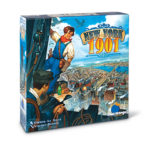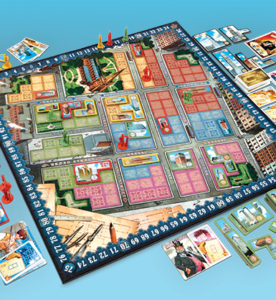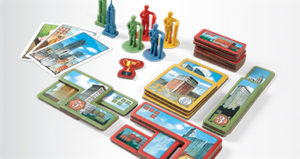Unplugged: New York 1901 (Boardgame)
 Become a real estate magnate by constructing the best and the most skyscrapers in New York. Players take turns claiming lots and placing buildings almost-Tetris style onto the game board. Larger buildings are harder to squeeze onto open spaces and are worth more points. At game end, bonus points are awarded for having the most buildings along specific streets as well as a special scoring that is different each game. New York 1901 is a solid entry in the family gaming category. Fun for the older folks, but still playable by the younger (early grade school) set.
Become a real estate magnate by constructing the best and the most skyscrapers in New York. Players take turns claiming lots and placing buildings almost-Tetris style onto the game board. Larger buildings are harder to squeeze onto open spaces and are worth more points. At game end, bonus points are awarded for having the most buildings along specific streets as well as a special scoring that is different each game. New York 1901 is a solid entry in the family gaming category. Fun for the older folks, but still playable by the younger (early grade school) set.
New York 1901
Publisher: Blue Orange Games
Ages: 8+
Players: 2-4
Time: 45 mins
(Review copy provided by Blue Orange Games)
The game board for New York 1901 displays several blocks in downtown New York, coded by five different colors.. Each block contains a grid of squares, with the squares labeled in groups of two or three. On a turn, a player will either select a color card from a tableau, and then either build a building somewhere on that color or place one of their workers on a group of squares of the corresponding color. Spots reserved by workers can be built over on future turns. Instead of selecting a colored card, players can replace a building onto the board that replaces one or more lower value buildings as well as any spots reserved by workers. Placing buildings on the board is the major source of points within the game.

Buildings come in various shapes and classes. Players start the game able to place bronze buildings, and unlock (after scoring a set number of points) the ability to place silver and gold buildings which are of higher value. Silver buildings can (but aren’t required to) overbuild bronze buildings, and gold can overbuild either bronze or silver. Gold buildings cannot be overbuilt, which can be problematic in the endgame. The overbuilt buildings are removed from the board, but a player does not lose the points already scored. Each player has their own limited supply of buildings. They come in various shapes, so advanced planning is important for the endgame where building space is at a premium. There are also four shared Legendary Buildings (named after four famous buildings.) Each has a high point value and are considered gold buildings, but only one can be built per player. In addition to their high point value (based on the height of the real-life buildings), the Legendary Buildings also serve as a tiebreaker at the end of the game.
The game ends when any player has only four buildings left or if the building cards run out. Players then score bonus points for meeting certain criteria. Three street cards are selected at the start of the game and the player with the most buildings adjacent to that street will score 5 points at the end of the game. All players who satisfy the special criteria (chosen from five possible ones at the start) also score points. Special criteria include building in each colored zone, building the irregular (non-square) buildings, or ending the game with specific level (bronze, silver, gold) buildings on the board.

Players also gain one point for each of their remaining action cards. At any point in the game, players may use one of each of the three different bonus actions. Only one can be used per turn. These let a player reset the card tableau (if none of the displayed cards are appealing,) select an extra lot card from the tableau, or build an extra building on a turn (players may normally only build one building per turn.) The action cards provide players yet another tactical opportunity during the game as they can be used as an element of surprise to the other players.
In practice, the game moves along smoothly. Initially, players are simply trying to claim large swaths of territory in order to build larger buildings on a later turn. However, players have a limited number of workers, so one cannot simply horde building lots without building anything. It is also important to eventually score enough points with bronze (and silver) buildings to unlock the ability to build silver (and gold) buildings. Later in the game, players begin to jockey for position to build their largest buildings as well as one of the legendary ones. At this point, players may start claiming areas just to deny others from expanding. Finally, there is a rush simply to get as many buildings onto the board as possible before the game ends. This makes the game an excellent fit for family gaming, as the arc of the game starts out slow and then tension builds as the board fills up.
Verdict:
New York 1901 is one of those modern boardgames that are easy to learn, but have enough strategy to be played again and again. Due to some of the difficulties of long-term planning (a player may not always find a lot card of the color needed), it doesn’t reach the heights of hit games like Ticket to Ride or Settlers of Catan. However, it still deserves a mention as a solid family title. It should be a welcome addition to any family’s gaming shelf.
Kid Factor:
Fairly simple rules, but does require a bit of forward planning. No reading to speak of, and the lack of direct player antagonism makes it a great candidate for early gamers. As a bonus, there is no hidden information so parents can give the youngest players occasional suggestions or advice.





Discussion Area - Leave a Comment